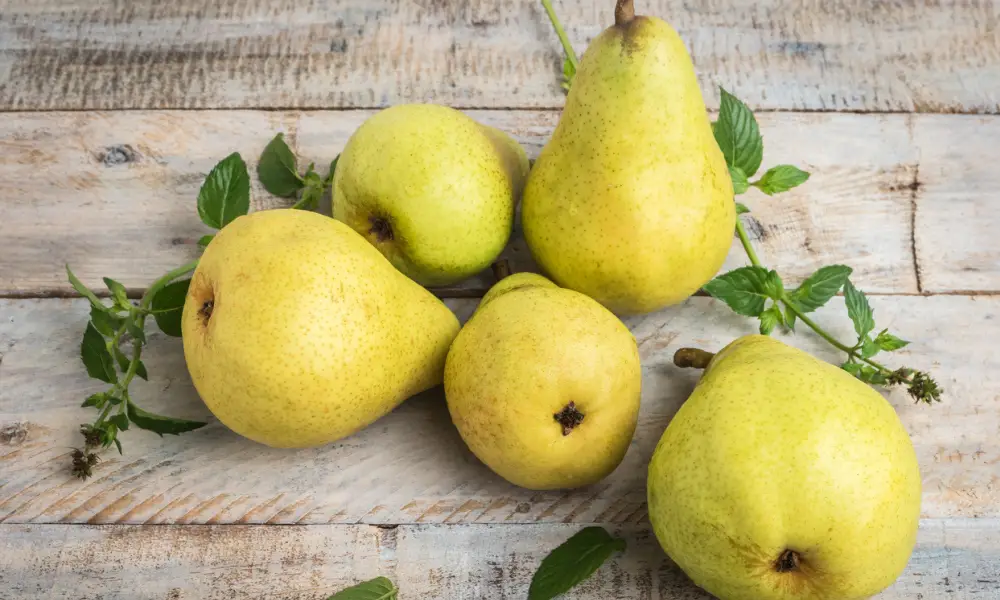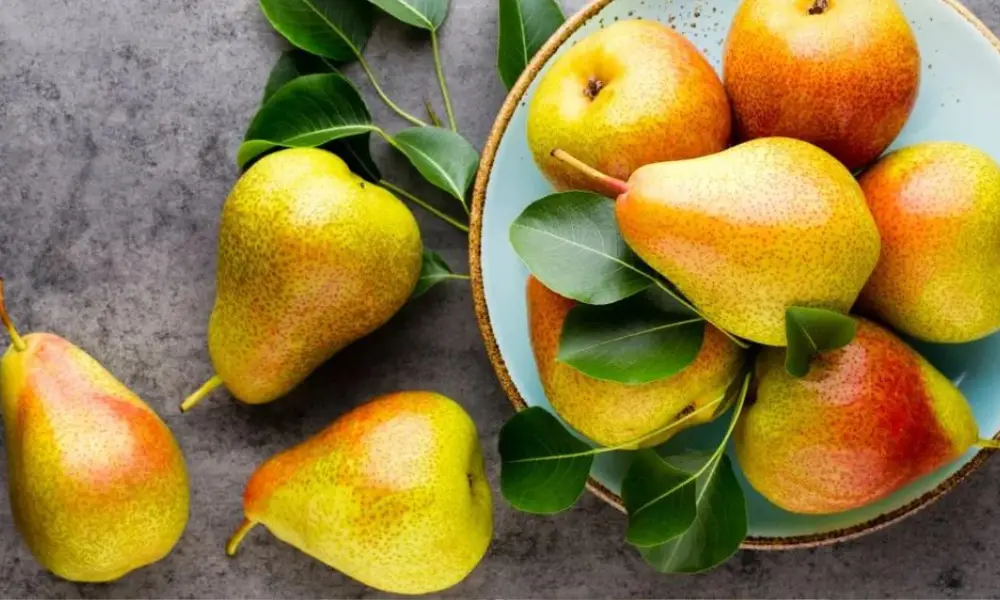Pears are a sweet and adaptable fruit that go well on their own and in many other recipes, such as salads and desserts. It makes sense why they’re so popular with so many people. Pears should be stored properly to maintain their freshness and flavor whether you want to consume them soon or in the future, if you want to enjoy them beyond their season or if you have more pears than you can eat right away.
Even though pears are only in season once a year, they can last for several months with careful storage. Follow these straightforward storage guidelines after gathering your pears and ensuring you have adequate refrigerator space or a cool storage place.

What are Pears?
Mature trees frequently generate huge quantities. A pear tree, which belongs to the rose family, produces an edible fruit of that name. The bell-shaped fruit is distinguished by its thin exterior skin, soft, delicious flesh, and tapered top. Since pears primarily comprise water, their main nutrient contribution is dietary fiber. Because they require little care, have lovely flowers, and can be trained to grow in a small area, pears are a common fruit tree for home gardens. Before you plant a pear tree in your garden, it’s critical to understand how to harvest pears and prepare them for long-term storage.
How to Store Pears?
For Short-Term Storage
- Check the ripeness of your pears. Pears are harvested from the tree when they are developed, not ripe, unlike most other fruits.
- After being harvested, they gently start to ripen from the inside out.
- You may determine the ripeness of your pears by gently pressing on the top, close to the stem. Your pears’ color alone is not a reliable indicator of whether or not they are ripe.
- Your pears are not ripe if the flesh is firm when you press on them.
- Buying unripe pears is fine if you intend to consume them within a few days.
- Pears are ripe when the flesh softens slightly when you press on them, and they are ready to be eaten immediately.
- Softness or bruising elsewhere on a pear may indicate an overripe affecting flavor and consistency.
- Unripe pears should be kept at room temperature. Your pears can continue to ripen by being kept at room temperature. They ought to be kept intact, not clipped. The temperature in the room is 70 °F (21 °C).
- Using the pressing method, you must check your pears daily to determine if they are ripe and ready to eat. Most pears mature 3 to 4 days after being bought.
- To keep ripe pears fresh, put them in the fridge. Ripe pears won’t survive very long in the cupboard or kitchen counter. The shelf life of these items can be increased by 5 to 12 days by storing them whole in the refrigerator. Your refrigerator should be at or below 40 °F (4 °C). If your pears have been sliced into pieces, carefully wrap them in a bag or container before storing them in the fridge to prevent air exposure.
- Avoid consuming rotting, bad, or ruined pears. Your pears are no longer appealing or secure to eat if they are browning, bruising, or blemishing. You’ll need to cut the pear open to determine whether or not you should eat it because a poor pear may appear healthy from the outside.
- You may still use pear in smoothies, jams, and sauces, even if it is only a little overripe and not rotting.
- Your unripe pears will ripen more quickly if you put them in a brown bag. You can hasten the ripening of your pears if you want to enjoy them as soon as possible. During the ripening process, fruits like pears emit ethylene, a hormone that is found in nature. Your pears will ripen more quickly if you put them in a brown paper bag because the hormone is trapped there.
- Your pears will ripen more quickly if you put them in a fruit bowl, among other ethylene-producing fruits like bananas, apples, and avocados.
For Long-Term Storage
- For simpler storage, cut the pears before freezing them. When pears aren’t in season, you may still enjoy their delicious flavor all year long by freezing them. You can choose whether the pears into half, quarters, or slices.
- Pears should be peeled and cored before cutting for optimal results. Several fruit peeling and cutting equipment are available to make this process easier if you’re not confident handling these tasks with just a knife.
- To prevent browning, soak the pears in a simple solution. Add either 1-2 tablespoons salt, 3-4 teaspoons ascorbic acid, or three tablespoons lemon juice to 1 quart of water. Add the pears to the mixture and let them soak for three to five minutes.
- Pear browning can be considerably decreased by pre-treating the pears before storing them.
- Place the already-treated pears in the freezer on a baking sheet or pan. Transfer them to the freezer on the baking sheet or tray, spreading them out evenly, so they all lay flat. Give the pears three to five hours to freeze. If you keep them unpackaged for too long, freezer burn may occur, affecting the flavor and texture of your pears.
- The pears will freeze separately rather than adhering together if they are frozen before going into their long-term storage bag or container.
- The pears should be placed in freezer-safe bags or containers and sealed. You can use mason jars, plastic containers with lids, or resealable plastic bags. Fill the bag or container halfway with the pears, leaving space between them to prevent overcrowding. Seal the bag or container after you’ve placed the pears inside.
- To prevent browning and freezer burn, remove as much air from the bag if you’re using it to keep the pears.
- To immediately identify the fruit and how long it has been in your freezer, mark the bag or container with the date and the name of the fruit.
- The pears should be frozen. To uniformly freeze the fruit thoroughly, lay the bags or containers flat. The freezer should be kept at or below 0 °F (18 °C).
- Pears can be kept frozen for 10 to 12 months.
What are the Two Main Types of Pears?
European and Asian pears are the two primary varieties of pears farmed for human consumption. Depending on your pear type, the ripening process will vary substantially.
European pears: Some of the most popular pears in North America are classified as European pears. They have soft internal flesh and delicate skin. Based on when they are harvested, they can be further divided into two groups: summer and winter. Bartlett pears are the one exception to the rule that most pear cultivars must be stored in cold storage before ripening. The only summer pear cultivar with a reliable storage life is Bartletts. Pears are grown in winter, such as Bosc, Anjou, and Comice- Once they are grown in size but unripe, they must be harvested. To delay ripening and allow the fruit to mature gradually, the unripe pears are kept in cold storage for four to eight weeks.
Asian pears: In appearance and texture, Asian pears resemble apples. You can eat them straight from the tree as they grow and ripen on the limb. While cold storage is not necessary for them, it can help increase their products’ shelf life by around three months.
Reference: Chemical compositional characterization of eight pear cultivars grown in China
How to Use a Syrup Pack to Freeze Pears?
Pears can be kept fresh throughout the year by freezing them when they are at their ripest. There are two ways to freeze pears, including freezing the pears in sugar syrup. The syrup gently sweetened Pears, making them a year-round delectable delicacy.
Prepare your pears. The fresh pears should first be rinsed in cold water. Put them in a solution made of one quart of water and one of the following for three minutes to prevent discoloration: three tablespoons of lemon juice, three-quarters of a teaspoon of ascorbic acid, or one-eighth of a teaspoon of citric acid. Drain your slices of pears, then. Peeling, coring, halving, and slicing your pears into quarters will finish off preparing them for freezing.
Make the sugar syrup. You can prepare a light syrup, a medium syrup, or a heavy syrup, depending on how sweet you want your pears to be. Mix one and a third cups sugar with four cups of water to make a thin syrup. Mix two and a third cups of sugar with four cups of water to make a medium syrup. Combine four cups of sugar with four cups of water to make a thick syrup. Heat the sugar and water until the sugar dissolves. Refresh the syrup.
Put the pears in containers that can be frozen. Add two-thirds of a cup of cooled syrup to every two cups of fruit. Leave a half-inch of headspace; for quart-sized containers, leave a one-inch headspace. Use the pears and syrup within eight to ten months after putting the containers in your freezer.
When are Pears Still Fresh?
Fully ripe pears will remain fresh in the fridge for three to five days. Pears should be taken out of cold storage and kept at room temperature on the counter or in a fruit bowl to ripen. Within three to ten days, they ought to be ready. Store pears in a brown paper bag with other fruits that release ethylene gas (the gas that causes fruits to ripen), such as avocados, bananas, or ripe apples, to hasten the ripening process. You may determine if it is ripe by gently pressing the pear’s neck with your thumb. The pear is ripe and ready to be eaten after the fruit’s stem ends begin to give slightly.
What Sort of Pears Make the Best Cooking Pears?
The red Bosc pear, the red and green D’Anjou pears, and the Bartlett, Forelle, and Concorde pears are the pear kinds best suited for baking. These pears are the best to cook with or bake since they maintain their shape and flavor even when heated to high temperatures.
Additionally, after being cut, they do not immediately turn brown. Use pears that keep together well when creating poached, roasted, or grilled pears. Look for the raw pears that are the crispiest to determine which pears can withstand heat; the well-known Bosc pear is the best choice.
Another great choice is Anjou pear, Concorde, and French butter pears. Additionally, after being cut, they do not immediately turn brown. Use pears that keep together well when creating poached, roasted, or grilled pears.
Look for the raw pears that are the crispiest to determine which pears can withstand heat. The well-known Bosc pear is the best choice, and Anjou, Concorde, and French butter pears are fantastic alternatives.
Additionally, after being cut, they do not immediately turn brown. Use pears that keep together well when creating poached, roasted, or grilled pears. Look for the raw pears that are the crispiest to determine which pears can withstand heat. The well-known Bosc pear is the best choice, and Anjou, Concorde, and French butter pears are fantastic alternatives.
Conclusion
The best way to store pears is to keep them in a cool, dry place, away from direct sunlight. Ideally, they should be in a medium-sized, blemish-free container in single layers. Avoid touching them. Handle pears carefully to avoid bruising. Pears ripen at different rates, so keep late season types separate from midsummer types to speed up the ripening process. Also, keep them away from other foods, including strong odors.

